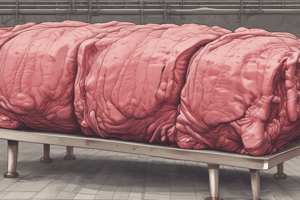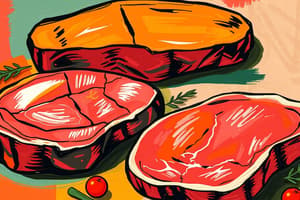Podcast
Questions and Answers
What is the primary reason why Prime grade beef is not economical for meat packers?
What is the primary reason why Prime grade beef is not economical for meat packers?
- The cattle have a shorter lifespan.
- The cattle are raised on organic feed.
- The cattle are bred specifically for Prime grade.
- The cattle are required to get very fat to obtain enough marbling. (correct)
What is the main difference between Choice and Select grades of beef?
What is the main difference between Choice and Select grades of beef?
- Marbling and carcass conformation (correct)
- Type of feed used
- Age of the cattle
- Region of origin
What is the purpose of Yield Grades?
What is the purpose of Yield Grades?
- To identify Prime grade beef
- To identify carcasses for differences in cutability (correct)
- To determine the price of beef
- To classify beef into different grades
What is the dressing percentage for Prime grade beef?
What is the dressing percentage for Prime grade beef?
What is the process by which the quality grade of beef is determined?
What is the process by which the quality grade of beef is determined?
What is the term for beef that is not acceptable for human consumption?
What is the term for beef that is not acceptable for human consumption?
What is the main characteristic of beef with a Yield Grade of 1?
What is the main characteristic of beef with a Yield Grade of 1?
What is the term for the percentage yield of chilled carcass in relation to the weight of the live animal?
What is the term for the percentage yield of chilled carcass in relation to the weight of the live animal?
What is the primary function of the reticulum in ruminants?
What is the primary function of the reticulum in ruminants?
What is the purpose of a magnet being fed to ruminants?
What is the purpose of a magnet being fed to ruminants?
What is the largest compartment in the ruminant digestive system?
What is the largest compartment in the ruminant digestive system?
What is the primary function of the omasum?
What is the primary function of the omasum?
What is one of the signs of a sick calf?
What is one of the signs of a sick calf?
What is the true stomach in ruminants?
What is the true stomach in ruminants?
What is a good management practice for disease prevention?
What is a good management practice for disease prevention?
How long is the gestation period for cattle?
How long is the gestation period for cattle?
What is the term for the process of ruminants bringing up feed from the rumen to complete the chewing process?
What is the term for the process of ruminants bringing up feed from the rumen to complete the chewing process?
What is the factor that determines the quality grade of beef based on the amount of fat interspersed in the muscle?
What is the factor that determines the quality grade of beef based on the amount of fat interspersed in the muscle?
What is the normal length of the estrous cycle in cattle?
What is the normal length of the estrous cycle in cattle?
What is the term for the highest quality grade of beef, characterized by superior marbling, proper carcass conformation, and adequate maturity?
What is the term for the highest quality grade of beef, characterized by superior marbling, proper carcass conformation, and adequate maturity?
When should heifers be bred for spring calving?
When should heifers be bred for spring calving?
What is the goal of reproductive performance in beef cattle?
What is the goal of reproductive performance in beef cattle?
How many females should a yearling bull be bred to in a 90-day breeding season?
How many females should a yearling bull be bred to in a 90-day breeding season?
What is the ideal time to introduce new animals to the herd?
What is the ideal time to introduce new animals to the herd?
Flashcards are hidden until you start studying
Study Notes
Beef Grading
- Found in fine restaurants and gourmet stores, Prime grade beef requires cattle to get very fat to obtain enough marbling, and only a small percentage of cattle meet the conformation standards.
- Choice grade is the most economical and most desirable carcass grade, requiring adequate marbling and carcass conformation.
- Select grade may be referred to as "no-roll" since it isn't stamped with the USDA grade, requiring slight marbling.
- Standard grade usually includes older animals and thin animals, with minimum marbling or below-average carcass conformation.
- Commercial grade includes designations of cutter, canner, and utility, usually processed into lunch meats, soup, and canned meat products.
- Cull grade is not acceptable for human consumption.
Yield Grades
- Identify carcasses for differences in cutability (the lean yield of a beef carcass) or yield of boneless, trimmed retail cuts.
- Yield grade is determined by hot carcass weight, external fat, percent heart, kidney and pelvic fat, and rib eye area.
- Types of yield grades include:
- Moderately Abundant
- Slightly Abundant
- Moderate
- Small
- Slight
- Yield grade 1 is the leanest, heaviest muscled carcass, and yield grade 5 is the lightest muscled fattest.
Dressing Percentage
- Dressing percentage is the percentage yield of chilled carcass in relation to the weight of the live animal.
- Dressing percent depends on the quality grade of the animal, with Prime being 62%, Choice being 60%, Select being 59%, and Standard being 57%.
Functions of the Compartments
- Reticulum (nicknamed the hardware stomach) furnishes additional storage space and holds foreign materials, often a magnet is fed to ruminants to catch and hold this foreign material.
- Rumen is the largest compartment, serving as a storage area for feed, with millions of bacteria and protozoa breaking down the feed.
- Omasum is a muscular section that squeezes out the water from the feed before it enters the abomasum.
- Abomasum (the true stomach) is where digestive juices begin chemical changes to break down the proteins, carbohydrates, and fats into simpler substances.
Meat
- Beef quality grades reflect differences in eating quality of meat based on marbling scores and maturity scores.
- Types of quality grades for beef are:
- Prime
- Choice
- Select
Signs of a Sick Calf
- Poor appetite
- Droopy ears
- Rapid, noisy breathing
- Dry, crusty or runny nose
- Gaunt gut
- Limping
- Patchy haircoat
- Diarrhea
- Swelled, tight left side
Good Management for Disease Prevention
- Be alert for signs of disease and conditions which can cause stress and strain.
- Provide clean, disinfected quarters, free from draft, with adequate ventilation and sunlight.
- Practice rigid sanitation and manure removal procedures.
- Provide a well-balanced diet.
- Get accurate diagnosis of health problems immediately.
- Avoid unnecessary stress and strain.
- Buy disease-free stock from healthy herds.
- Isolate new animals for a period before introducing them to your herd.
- Follow a set vaccination program.
- Be cautious of visitors from other operations as they may carry disease pathogens.
Reproduction
- Estrous cycle: 21 days
- Gestation period: 10 months
- Nursing period: 7 months
- Stocker period: 4 months
- Feedlot period: 4 months
- Processing period: 1 month
- Conception to plate: 26 months
Breeding
- Breeding season: April and May for spring calving, January and February for fall calving.
- Heifers are bred beginning 30 days before the older cows.
- Breeding season management: most beef cows are pasture bred, where bulls run with the cows during the breeding season.
- Yearling bulls should not be pasture bred to more than 10 females in a 90-day breeding season.
Studying That Suits You
Use AI to generate personalized quizzes and flashcards to suit your learning preferences.




